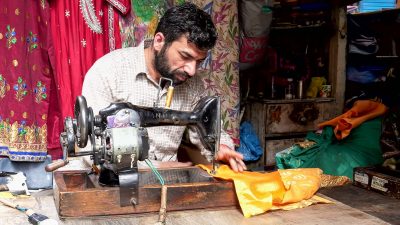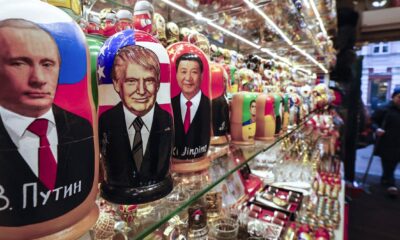Trade
‘Make in India’ a work in progress

Author: Aasheerwad Dwivedi, Delhi University
Historical experience presents ‘structural transformation’ as a necessary condition for achieving high economic growth in any country. The typical transformation path involves people moving from agriculture towards industries and then services, from low to high productivity sectors, and from villages to cities. To the sorrow of millions, India missed the bus in the 1960s and — unlike its Eastern neighbours such as China — followed its own atypical path.
India’s latest attempt to move up the value chain is the ‘Make in India’ initiative introduced in 2014, which emphasises creating world-class infrastructure, minimising red tape, promoting innovation-friendly policies and improving the ease of doing business. Its timing was seemingly perfect amid the trade opportunities ostensibly created by souring China–US trade relations.
Seven years after its introduction, the euphoria is low. The manufacturing sector’s share of Indian GDP is merely 15 per cent, despite the initiative targeting 25 per cent by 2022. The growth rate of manufacturing averaged 4.5 per cent from 2014–2021 — meaning the scheme is similarly unable to deliver the 100 million manufacturing jobs promised by policymakers. Although FDI has doubled since 2014 (US$81.72 billion in 2020–2021), most investment has flown into services and computer software or hardware.
Indian exports increased from US$310 billion in 2014 to just US$313 billion in 2020, with their composition largely unchanged. The EU-28 is still India’s main export destination, followed by the United States and other Asian countries (together comprising one-third of the total exports).
While failing to produce any significant result on the trade front, the scheme has had some success in attracting investment in mobile manufacturing, automobile and pharmaceuticals. Global brands like Samsung, Hitachi, Kia, Apple and PSA have started manufacturing in India, with India’s share of smartphone manufacturing doubling from 10 per cent to 20 per cent between 2017 and 2020.
To provide additional thrust to the ‘Make in India’ initiative, a ‘production-linked incentive’ was introduced in March 2020 to improve local supply chains and spur investment in high-tech production. To increase economies of scale, the government is subsidising manufacturers to invest in technology and supply chain improvements if they produce above a certain threshold.
The scheme covers 13 sectors, including pharmaceuticals, mobile phones, auto-components and textiles, with a total outlay of US$26.48 billion. Since the scheme is aimed at making domestic producers competitive and reducing import dependence, it is tailor-made for a post-COVID-19 world in which the benefits to a diversified manufacturing base are amplified.
Yet the hurdles to government-led manufacturing lie in policy inconsistency and poor sectoral targeting. Once the state provides protection, it is difficult to withdraw and difficult to discern what will happen in the absence of protection. India’s protectionist past is evidence of this difficult balancing act.
While the Indian government has rolled out policies to promote exports, trade policy is more inwardly oriented. The ‘Make in India’ initiative ignores the decades-long geographical fragmentation of the global production process, a reality that increases the import dependence of exports. The correlation between Indian imports and exports in the post-reform period stands as high as 0.75. Export growth requires India’s greater integration into global value chains — a feat achieved by China and Vietnam, where there is 40 per cent foreign value added in garment exports.
India’s average MFN tariff declined from 125 per cent to 13 per cent between 1991 and 2014, then increased from 13 per cent to 18 per cent from 2014 to 2018. This inward outlook can be explained by India’s signing of 11 free trade agreements between 2004 and 2014 — but none since then. India did not join the Regional Comprehensive Economic Partnership (RCEP), but is actively consulting with the United Kingdom over a free-trade agreement and is in advanced trade discussions with Australia, the UAE and Canada.
While it is too early to draw firm conclusions about the production-linked incentive scheme, an initial assessment indicates it suffers from poor targeting. There is enormous potential to increase labour-intensive exports in India, but only three out of the thirteen sectors targeted by the scheme — automobiles and auto components, mobile…
Trade
Self-Reliance and Openness: Core Principles of China’s Third Plenary Session

The Third Plenum communique from the CCP indicates a prioritization of stability and compromise in response to China’s economic challenges. It highlights the concept of Chinese-style modernization and establishes political guidelines for balancing regulation and market forces.
The CCP’s Third Plenum communique signals a focus on stability and compromise in the face of China’s economic challenges. It emphasises Chinese-style modernisation and sets political directions for balancing regulation and market forces. While not as groundbreaking as previous plenums, it acknowledges the importance of market mechanisms and technological self-reliance, aiming to address issues like high youth unemployment and private sector uncertainty. The communique seeks to navigate the complexities of global competition and domestic innovation, potentially reshaping global supply chains and trade dynamics. Overall, it presents a pragmatic blueprint for China’s economic future.
Source : Self-reliance and openness central pillars of China’s Third Plenum | East Asia Forum
Trade
Trade Prevails Over Political Persuasions in China-Germany Relations

China and Germany maintain a strong bilateral relationship, rooted in economic cooperation despite ideological differences. Recent visits and agreements focus on expanding trade and addressing mutual concerns, navigating challenges while nurturing ties.
Evolving Bilateral Ties
China and Germany share a strong bilateral relationship, rooted in history since 1972. This connection has seen moments of cooperation intertwined with periods of tension. German Chancellor Olaf Scholz’s April 2024 visit underscores Germany’s commitment to fostering this partnership, reflecting a mutual interest in maintaining economic ties despite ideological differences.
Economic Pragmatism
As the second and third largest global economies, China and Germany’s economic interdependence is crucial. Germany emerged as China’s primary trading partner in 2023, with trade values reaching €254.4 billion (US$280 billion). In response to global scrutiny, Germany has taken a balanced approach, emphasizing economic stability over political discord. This was evident during Scholz’s prior visit in November 2022, where his diplomatic tone contrasted with broader EU sentiments.
Facing Challenges Together
Despite increasing public skepticism in Germany regarding China’s global influence and human rights issues, both nations continue to seek common ground. Their October 2023 Joint Statement highlights intentions to pursue cooperation in areas like carbon neutrality and open markets. To navigate these complex terrains, Germany can utilize its institutional frameworks to enhance dialogue, while also considering supply chain diversification to reduce dependency on China. The intertwining nature of their economies suggests that, despite challenges, both countries will continue to prioritize their substantial trade relations.
Source : Trade trumps political persuasions in China–Germany relations
Trade
Fixing fragmentation in the settlement of international trade disputes

Fragmentation in global trade due to the lack of development in multilateral trade rules at the WTO has led to an increase in FTAs. The Appellate Body impasse has further exacerbated fragmentation, requiring a multilateral approach for reform.
Fragmentation in Global Trade
Fragmentation in global trade is not new. With the slow development of multilateral trade rules at the World Trade Organization (WTO), governments have turned to free trade agreements (FTAs). As of 2023, almost 600 bilateral and regional trade agreements have been notified to the WTO, leading to growing fragmentation in trade rules, business activities, and international relations. But until recently, trade dispute settlements have predominantly remained within the WTO.
Challenges with WTO Dispute Settlement
The demise of the Appellate Body increased fragmentation in both the interpretation and enforcement of trade law. A small number of WTO Members created the Multi-Party Interim Appeal Arbitration Arrangement (MPIA) as a temporary solution, but in its current form, it cannot properly address fragmentation. Since its creation in 2020, the MPIA has only attracted 26 parties, and its rulings have not been consistent with previous decisions made by the Appellate Body, rendering WTO case law increasingly fragmented.
The Path Forward for Global Trade
Maintaining the integrity and predictability of the global trading system while reducing fragmentation requires restoring the WTO’s authority. At the 12th WTO Ministerial Conference in 2022, governments agreed to re-establish a functional dispute settlement system by 2024. Reaching a consensus will be difficult, and negotiations will take time. A critical mass-based, open plurilateral approach provides a viable alternative way to reform the appellate mechanism, as WTO Members are committed to reforming the dispute settlement system.
Source : Fixing fragmentation in the settlement of international trade disputes







